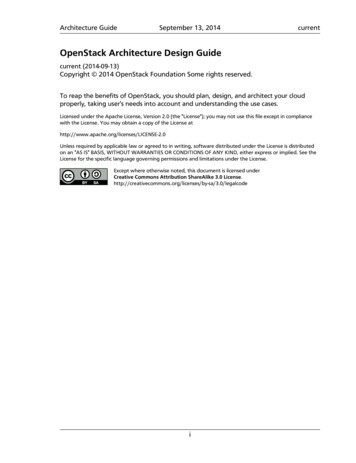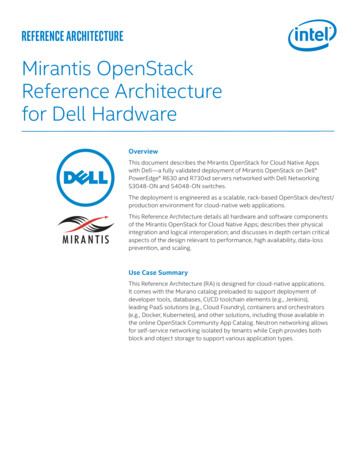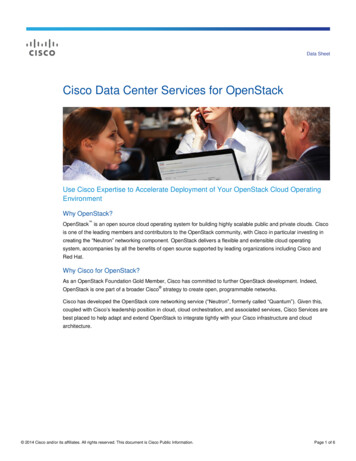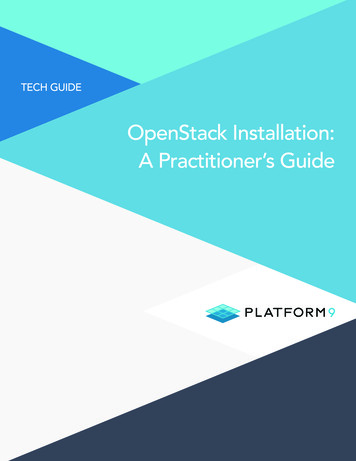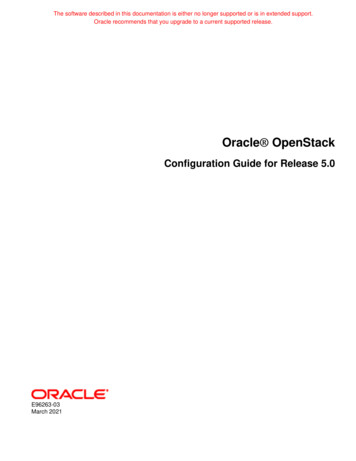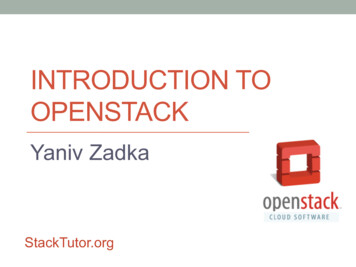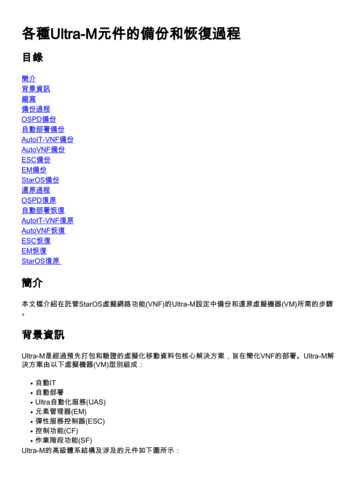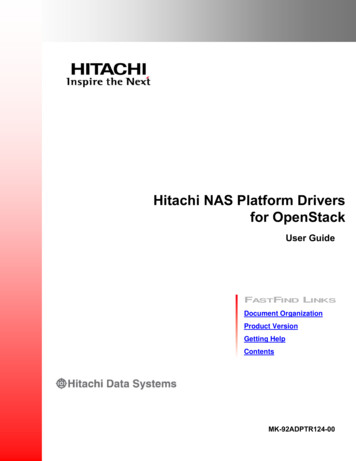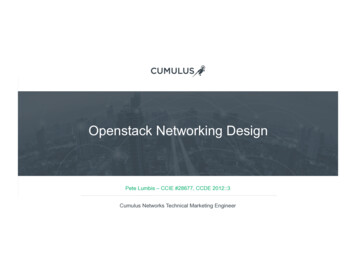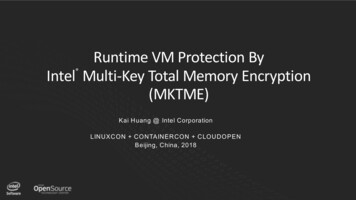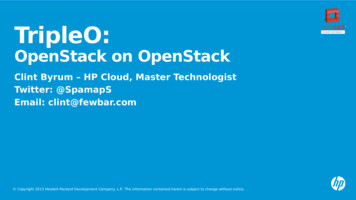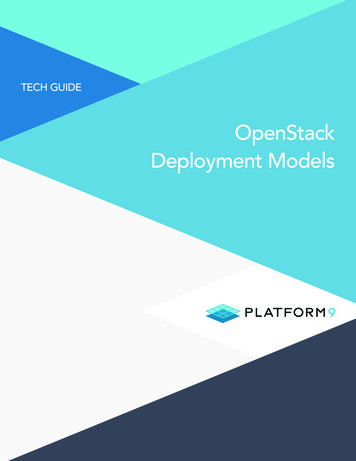
Transcription
OpenStack CommunityWelcome GuideRevision 17release date: 26. Aug. 20161
Table of ContentsGetting Started with the OpenStack Community.3What is OpenStack? . 3OpenStack Principles. 4OpenStack Projects. 4Release Process. 5Planning. 5Design Summits. 5Launchpad Blueprints. 5Implementation. 5QA. 5Release. 5Governance. 6The OpenStack Foundation. 6OpenStack Community. 6OpenStack Developers . 6Launchpad ID (OpenID provider).7Licensing. 7Contributor’s wiki. 7Core Principles. 7Get the Code. 7Bugs. 7Other good resources for developers.8Documentation. 8Contribute to Documentation. 8OpenStack Ecosystem. 8Sponsor the OpenStack Foundation .8Individual Member of the Foundation .9OpenStack User Groups.10Other useful tools. 10Wiki. 10Bug Reporting. 10Keeping in touch. 10Mailing Lists. 11OpenStack Events. 11OpenStack Wiki Layout. 11Starting Page http://wiki.openstack.org/StartingPage .12Recent Changes . 12Find Page . 12Help Contents . 12Revision 17release date: 26. Aug. 20162
Revision 17release date: 26. Aug. 20163
Getting Started with the OpenStack CommunityWelcome to the global OpenStack community, home of the leading open sourcecloud infrastructure solution. This document is meant for anyone interested inlearning more about OpenStack, how the community operates, and where to go forthe information you need. It is intended for new community members looking to getstarted, and as a way to quickly understand the development process and basiccommunity “rules.”If you need more information or have additional questions, please contact thecommunity manager, Tom Fifield, at communitymngr@openstack.org.What is OpenStack?OpenStack is a cloud operating system that controls large pools of compute,storage, and networking resources throughout a datacenter, all managed through adashboard that gives administrators control while empowering their users toprovision resources through a web interface.The OpenStack project is a global collaboration of developers and cloud computingtechnologists producing the open standard cloud computing platform for both publicand private clouds. The project aims to deliver solutions for all types of clouds bybeing simple to implement, massively scalable, and feature rich. The technologyconsists of a series of interrelated programs delivering various components for acloud infrastructure solution.OpenStack Principles Open development model: All of the code for OpenStack is freely availableunder the Apache 2.0 license. Code reviews and roadmaps are public.Revision 17release date: 26. Aug. 20164
Open design process: Every six months the development community holdsa design summit to gather requirements and write specifications for theupcoming release. The summits are open to the public and attendees includeusers, developers, and upstream projects.Open community: OpenStack is dedicated to producing a healthy, vibrant,and active developer and user community. Most decisions will be made usinga lazy consensus model. All processes are documented, open andtransparent.OpenStack ProjectsThe OpenStack project is organised around three major concepts (compute, storage,networking) and shared services. OpenStack Compute: Provision and manage large networks of virtualmachines. Codename Nova.OpenStack Storage: Object storage (codename Swift) and Block storage(codename Cinder) for use with servers and applications.OpenStack Networking: Pluggable, scalable, API-driven network and IPmanagement.OpenStack has several shared services that span the three pillars of compute,storage and networking, making it easier to implement and operate your cloud.These services including identity, image management, a web interface andmany more, integrate the OpenStack components with each other as well asexternal systems to provide a unified experience for users as they interact withdifferent cloud resources. More details on http://www.openstack.org/softwareRelease ProcessOpenStack is currently on a 6-month release cycle, which consists of four stages.Details on se-management.htmlPlanningThe Planning stage usually lasts 3 weeks and consists of discussion and feedback onwhat the next release will focus on. After deciding on the features, we write thecorresponding specs on how to make them happen. The Design Summit usuallytakes place during the second week of the planning stage.Design SummitsDuring the summit developers submit session ideas to discuss upcoming featuresfor the next release cycle. These features get reviewed and scheduled by thesummit drivers. The sessions are not formal presentations but rather opendiscussions on a given subject or feature. Summits happen every 6 months, in thespring and fall, so check the events listing for the next one. Details onhttp://wiki.openstack.org/SummitRevision 17release date: 26. Aug. 20165
Launchpad BlueprintsOpenStack uses Blueprints to track the design and implementation of significantfeatures during the planning and implementation stages. Details entationThe Implementation stage is split into a number of milestone iterations. The work inprogress is published in a branch, which should then be proposed for merging whenready. Code is proposed several weeks before each milestone release date so that itcan be reviewed in a timely manner.QAThis is the testing phase. Testing, prioritizing bugs, and documentation are keyparts of the QA phase. Only branches that fix bugs and do not introduce newfeatures are allowed to enter the release branch.ReleaseThe Release Candidate period is typically several weeks before the actual ReleaseDay. OpenStack releases are numbered using a YYYY.N time-based scheme. Forexample, the first release of 2015 will have the 2015.1 version number. During thedevelopment cycle, the release is identified using a codename. Those codenamesare ordered alphabetically: Austin was the first release, Bexar is the second, Cactusthe third Diablo, etc.These codenames are chosen by popular vote among a pool of cities or countiesnear where the corresponding OpenStack design summit took place. An exception(called the Waldon exception) is granted to elements of the state flag that soundespecially cool. More details on aming.html.GovernanceAs of September 2012, the OpenStack project is governed by a number of bodies,defined by the OpenStack Foundation bylaws nstack-foundation/ Foundation board of directorsTechnical CommitteeUser CommitteeThe OpenStack FoundationThe OpenStack Foundation promotes the development, distribution and adoption ofthe OpenStack cloud operating system. As the independent home for OpenStack,the Foundation is made of thousands of individual members from all over the worldand hundreds of different organizations, secured more than USD 10 million inRevision 17release date: 26. Aug. 20166
funding and is ready to fulfill the OpenStack mission of becoming the ubiquitouscloud computing platform.The goal of the OpenStack Foundation is to serve developers, users, and theentire ecosystem by providing a set of shared resources to grow thefootprint of public and private OpenStack clouds, enable technologyvendors targeting the platform and assist developers in producing thebest cloud software in the industry.Like the software, membership within the OpenStack Foundation is free andaccessible to anyone. Members are expected to participate in the OpenStackcommunity through technical contributions or community building efforts. Join thefoundation on https://www.openstack.org/join/The Foundation wouldn't be possible without the support of so many innovativecompanies that have contributed in many different ways. To learn more about ourPlatinum, Gold, Corporate Sponsors and other supporters, check out the supporterrecognition page. More details on http://www.openstack.org/foundation/OpenStack CommunityOpenStack is a global community consisting of developers, corporations, serviceproviders, researchers, and users.OpenStack DevelopersLaunchpad ID (OpenID provider)Launchpad is the official OpenID provider for most of the tools used for projectmanagement and development. Most people will need to have a Launchpad ID onhttp://launchpad.net to commit code, edit the wiki and other activities.LicensingIf you are a developer that would like to contribute to one of the above core projectsyou will need to sign an Individual Contributor License Agreement.If you are contributing on behalf of a company, an authorized representative of yourcompany should also sign a Corporate Contributor License Agreement. You'll findthe most up to date instructions on how to sign the agreements onhttp://wiki.openstack.org/HowToContribute (don't follow bookmarks from olderinstructions as they may reference to invalid processes).Core PrinciplesFamiliarize yourself with core OpenStack principles:1. What “Open” means http://wiki.openstack.org/Open2. Design tenets n 17release date: 26. Aug. 20167
3. Coding standards http://wiki.openstack.org/CodingStandards4. The release cycle semanagement.html5. The OpenStack branch model http://wiki.openstack.org/BranchModelGet the CodeOpenStack manages source code in git using a code review tool called Gerrit. Theworkflow for working with Gerrit is described s.html . Git repositories aremirrored to Github for ease of fetching, but pull requests are not accepted there.Instead use the Gerrit Workflow.To get a copy of any of the other OpenStack projects, you can look at the GithubOpenStack organization and browse, or you can clone a repo. More details onhttp://wiki.openstack.org/GettingTheCodeBugsBugs can be a good place to get your coding feet wet. The bugs confirmed andtriaged that should be simple to tackle are tagged ‘low hanging fruit’https://bugs.launchpad.net/openstack/ bugs?field.tag low-hanging-fruitOther good resources for developers Development Mailing List: /openstack-dev IRC#openstack on Freenode Pop In (via browser client) Meetings http://wiki.openstack.org/MeetingsProject meetings are held publicly on IRC.Documentation Getting Started Get up and running quickly with DevStack or TryStackhttp://www.openstack.org/software/start/ Installing and running OpenStack Installation, Configuration and Deploymentguides for production-sized systems and how to use themhttp://docs.openstack.org Operations Guide Architectural planning and operations guide OpenStackcloud service providers http://docs.openstack.org/ops Security Guide An overview of security best practices, guidelines, andrecommendations for increasing the security of an OpenStack deploymenthttp://docs.openstack.org/sec/Revision 17release date: 26. Aug. 20168
Developing OpenStack Python developer documentation, continuousintegration documentation, and language bindings documentation forOpenStack projects http://docs.openstack.org/developer SDKs Resources for application development on private and public OpenStackclouds. http://developer.openstack.org/ API Documentation on the RESTful APIs provided by OpenStack l Glossary A list of terms and their ent/glossary.htmlContribute to DocumentationAt the core of OpenStack is the community and collaboration that we do - the samerules for the code apply to documentation too. Ideally any code contribution that ismerged into the base has documentation to go with it. The pagehttp://docs.openstack.org/contributor-guide describes the methods we use to createthe basis for world-class documentation for OpenStack developers and users.OpenStack EcosystemA robust ecosystem is essential to OpenStack’s success. There are several ways youor your organisation can join this growing and vibrant ecosystem.Individual Member of the FoundationAny person can join the OpenStack Foundation for free. Individual Members:1. Get active in the OpenStack community as a user, developer, businessperson, art maker, or however you want to contribute2. Run for an elected position such as Project Technical Lead for projects youcontribute to, Technical Committee Member, or Foundation Board of DirectorsMember3. Vote in elections such as for the Board of Directors4. Stay informed of the latest OpenStack news through member updatesBecome a Supporting OrganisationFill out the form and send your logo to supporterlogos@openstack.org to have itlisted on our website.Sponsor the OpenStack FoundationOrganizations can apply to become new Gold Members, and will become Memberssubject to board approval. Learn more on http://openstack.org/joinCompanies can also choose to become Corporate Sponsor of the Foundation withtwo sponsorship levelsRevision 17release date: 26. Aug. 20169
Corporate Sponsor (Start Up)A “Start Up” is defined as “in business less than 2 years and less than 5 millionrevenue”. The quota for is set to 10k/year and grants: Access to OpenStack restricted use logos for commercial use if and as long asproduct meets technical requirements (your support helps the foundationpromote and protect the OpenStack brand)Designation as Startup sponsor with corporate logo placement in supporterssection of openstack.orgProfile on openstack.org detailing your organization's support for OpenStack,with a link to your siteEarly access to sponsorship opportunities, like OpenStack Design Summit &ConferenceOpenStack Startup Sponsor badge available for corporate website ormarketing materialOpportunity to be included in OpenStack newsletterCorporate Sponsor (Established Company)For companies that are not “Start Up” the quota is set to 25k/year and grants: Access to OpenStack restricted use logos for commercial use if and as long asproduct meets technical requirements (your support helps the foundationpromote and protect the OpenStack brand)Designation as Corporate sponsor with corporate logo placement insupporters section ofopenstack.orgProfile on openstack.org detailing your organization's support for OpenStack,with link to your site Early access to sponsorship opportunities, likeOpenStack Design Summit & Conference, before non-sponsorsOpenStack Corporate Sponsor badge available for corporate website ormarketing materialsOpportunity to be included in OpenStack newsletterOpenStack User GroupsOpenStack users from around the world are creating local OpenStack User Groupsto promote the open source project and their associated technologies. Find yourlocal group at https://groups.openstack.org.If there is no group in your area and you are interested in establishing a user groupin your area, please join the International Community mailing list nfo/communityRevision 17release date: 26. Aug. 201610
Other useful toolsQuestions and Answers (ask.OpenStack.org)The place where people can ask questions and give answers about OpenStackdeployments, operations and development https://ask.openstack.org.WikiA lot of good information on getting started with OpenStack core projects can befound in the wiki. The search function in the upper right hand corner of the wiki isvery powerful and is searchable by both title and by content.http://wiki.openstack.org/Bug ReportingThe OpenStack community appreciates testers and their feedback. To report a bugyou must first sign up for a Launchpad account.Check that the bug you found has not already been reported by searching theLaunchpad bugs list: https://bugs.launchpad.net/openstack/ bugs?orderby importance&field.status:list CONFIRMED&field.status:list TRIAGEDIf you found a new bug, fill out a bug report: Give a clear, concise summaryProvide as much detail as possible in the description. Paste in your commandoutput or stack traces, link to screenshots, etc.Be sure to include what version of the software you are using. This isespecially critical if you are using a development branch. Example: "Austinrelease" vs lp:nova rev.396.Any deployment specific info is helpful as well. Example: Ubuntu 14.04, multinode install.Keeping in touch Twitter: @openstack The OpenStack Blog: http://www.openstack.org/blog/ A blog aggregated from developers and other key players of OpenStackprojects: http://planet.openstack.org/ Internet Relay Chat (IRC) is where developers hold real-time discussions onvarious projects. Public meetings are also held on IRC. Channel #openstackon Freenode (http://webchat.freenode.net via browser client) Official YouTube Channel with videos from conferences and other interestingmaterial: http://www.youtube.com/openstackfoundation If you have any questions about OpenStack, and haven’t been able to findanswers elsewhere, try one of these knowledgeable people:http://wiki.openstack.org/ContactRevision 17release date: 26. Aug. 201611
Mailing ListsThe project runs many mailing lists. The most important ones are: General list You should join this list when you start to know OpenStack.Request for help and community announcements are allowed on this list. Itsrate can be up to 100 messages per day.http://wiki.openstack.org/MailingLists#General ListDevelopment list This list for the developers of OpenStack to discussdevelopment issues and roadmap. It is focused on the next release ofOpenStack: you should post on this list if you are a contributor to OpenStackor are very familiar with OpenStack development and want to discuss veryprecise topics, contribution ideas and similar. Do not ask support requests onthis list. http://wiki.openstack.org/MailingLists#Development ListOperators This is a specific list for existing OpenStack cloud operators. It is aforum to exchange best practices around operating an OpenStack installationat scale. You can ask for support on this orsOpenStack EventsOpenStack Summits take place every 6 months. OpenStack also participates inmany cloud and open source conferences throughout the year.If you are planning an OpenStack event or meet up and you would like it added tothe events page http://openstack.org/community/events/ please email your eventinformation to events@openstack.org.Revision 17release date: 26. Aug. 201612
OpenStack Compute: Provision and manage large networks of virtual machines. Codename Nova. OpenStack Storage: Object storage (codename Swift) and Block storage (codename Cinder) for use with servers and applications. OpenStack Networking: Pluggable, scalable, API-driven network and IP management.
